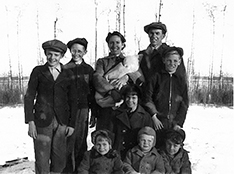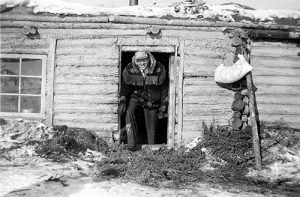
Annual Workers’ Conference at Meadow Lake, SK, in the early years.
“It was not a ‘burning bush’ – just a small campfire over which our smoke-blackened tea pail was hanging as we took a break for a sandwich and a spot of tea,” wrote NCEM’s first missionary, Stan Collie. “We did not have a flock — but a dog team; not a rod — but two axes and a Swede saw. But I believe the great ‘I AM’ was with us as He was with Moses, directing our thoughts and giving us our marching orders.
“Art Tarry and I were cutting firewood in a stand of fire-killed poplar and jack pine along the shore of the lake. We had received a glimpse of a vast mission field — a tribe, a nation, blinded by the prince of this world. The adversary had them shackled by fear, superstition and idolatry.
“So around the campfires, and around our kitchen tables in the evenings, we were making plans for the future. There was no other evangelical mission in Canada taking the Gospel of Christ to the Natives (specifically), or we probably would have tried to affiliate. To form a nonprofit mission it would be necessary to incorporate. ‘Where do we start?’ we wondered. As the Lord of the burning bush said to Moses, ‘Go, I am sending you. I will be with you,’ so we just went ahead.”

Stan & Evelyn Collie and children, 1948.
Stan Collie always humbly shrugged off the title “Mission Founder.” Concerning his part in NCEM’s beginnings, he said, “I was just one of the guys there.” Indeed, the founding of the Mission was a group effort, but Stan & Evelyn Collie played a key role, for they were NCEM’s first missionaries. The Collies were the first to go North and their doing so challenged all who followed. Hearing their story, one can appreciate how easy it would have been for them to take a less difficult path.
Spying Out the Land
It was 1939 when Stan described his first trips into northwestern Saskatchewan as “spying out the land” — looking for a place where he could begin the work he felt God calling him to do.
By 1940 there would be a family on this new mission field. Stan’s wife, Evelyn, and their five children, the eldest only seven years of age, had arrived with him at Buffalo Narrows. Stan and Evelyn later talked very little of the hardships of those first years: the building of a house with only their children’s help, of living on fish and cornmeal, and cleaning stables for fishermen just to survive. No church was supporting them financially. Though content with what they had, Stan expressed his frustration with the situation once when he wrote, “The days seem to be so filled with making provision for the needs of our bodies, and there is so little time for telling the Gospel story.”
It took the independent spirit of Stan Collie to do what he was doing, but he was not a loner. He had seen a vast area untouched with the Gospel and he was beginning to realize that it was just the fringe. He knew it was far too much for one man.
While the Collies were following the call of God in Canada’s North, God was working to bring more workers into this mission field. An itinerant preacher by the name of Isaac Reine was actively influencing others to pray and to consider giving their own lives to a similar purpose. Although under appointment as a missionary to Africa, Isaac took time to share his burden for the North with Christians across western Canada.
A Missionary Band is Formed

Art Tarry ministering in a northern home.
Art & Martha Tarry were serving a rural church in central Saskatchewan and had gained interest in the Collies’ ministry at Buffalo Narrows. Correspondence between Isaac Reine, the Tarrys, and the Collies was an initial step in the formation of a missionary band. More significant was a growing force of Christians who were beginning to pray that the Lord would send workers to this needy mission field of which they had only
recently been made aware.
Stan Collie later commented that until that time he, like Elijah, had felt he was the “only one.” But in the next few years, he would be meeting many Christians interested in ministry to Native people, and many who had been praying for him and Evelyn. In 1944 Stan met with different missions and the resulting decision was that the mission in Buffalo Narrows would join the Canadian Sunday School Mission (now One Hope Canada).
Following this, Isaac Reine moved east for further preparation for Africa. However, he would not be remembered for a missionary career. Sadly, he soon after died in a plane crash while training as a pilot in southern Ontario. He is remembered as a man deeply committed to Christ’s Great Commission … a man who, by word and example, did not shirk from challenging Christian believers about their responsibility to reach the lost. He is remembered for believing in the underlying role of prayer in missions.
For it was while he was making the needs of the spiritually lost known, through prayer God was raising up a missionary band that would give many of Canada’s First Peoples an opportunity to hear of His saving grace.
Presumption or a Vision from God?
The joining with CSSM was helpful for the first years, but the structure, headquarters location, and other factors made it necessary to seek God’s will for the next steps in the mission to Canada’s North. After much prayer in the unity of the Spirit, and with CSSM’s blessing, it was decided best to sever official connections. Stan Collie admitted that it was done with “fear and trembling,” but told also of God’s confident leading.

Missionaries Cliff & Ingeborg McComb with some of the first believers at Weagamow Lake, ON, circa 1950.
The vision of the founding figures was one of tremendous size and faith. Bud Elford, a past General Director of NCEM, wrote: “It was an impossible dream, a ridiculous mandate. Consider for a moment: a few not highly educated people, poorly supported, little known, with no influential backing, actually drawing up a mandate and making plans to bring the Gospel of Jesus Christ to every northern Indian village in Canada. It was either the height of presumption or else a vision from God. Everything that faced that tiny group was impossible.”
Since NCEM’s official organizing in 1946, this particular vision has been transferred to many others, to men and women who actually believe that God intends that every Indigenous community be reached for Him. Since 1946 many missionaries have committed their lives to its fulfillment.
Over 75 years ago Stan Collie and his family began a journey of vision and faith that was to become what is now NCEM. We are so grateful to the Lord for what He has done. We are so grateful for the obedient lives of faith of those who committed themselves to follow the Lord’s calling. We thank the Lord for our rich history of faith, and may the Lord continue to call His people to “fulfill the Great Commission of Jesus Christ among and in partnership with the Aboriginal Peoples of Canada and related people groups.”


